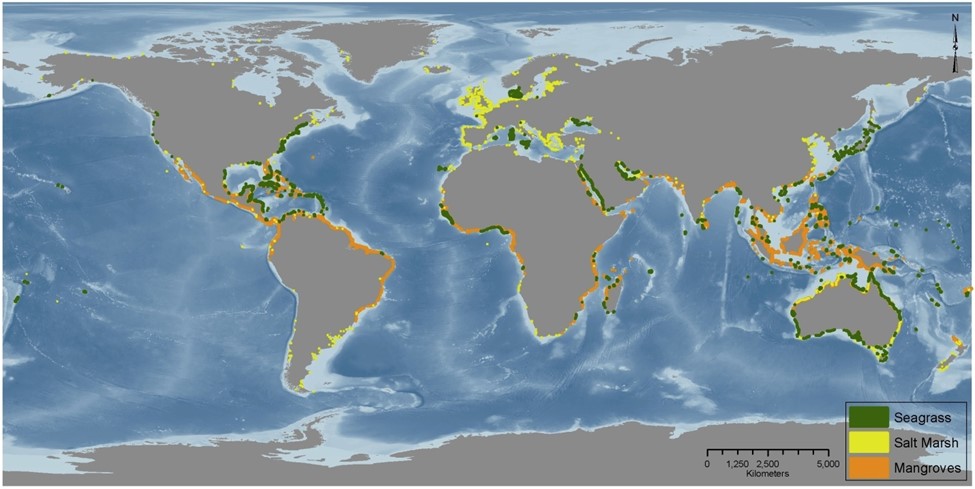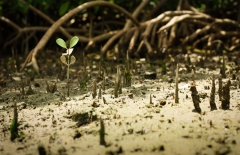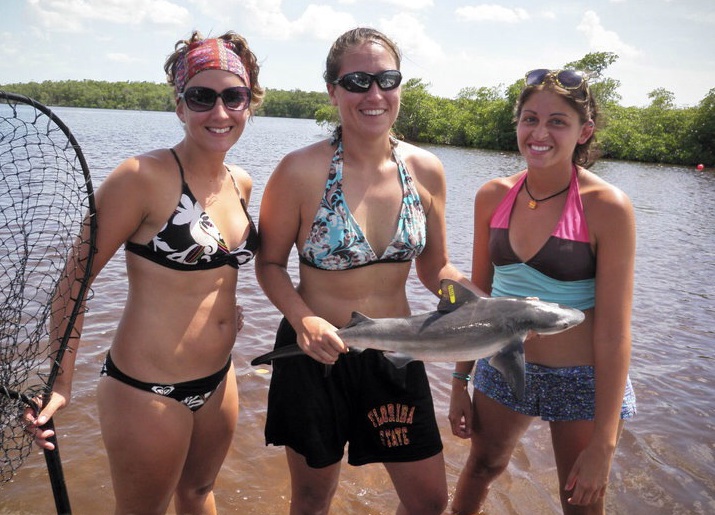Knauss legislative fellowships in Congress help build careers — and they're fun and educational. See our video and fact sheet for details.
Tapping the Climate Mitigation Potential of Blue Carbon Ecosystems
Adapting to a changing climate is arguably one of the most significant puzzles of our time. As a Knauss Marine Policy Fellow in NOAA’s Climate Program Office, I am exploring some of the many approaches that NOAA and other organizations are taking to prepare the United States and the world for the impacts of a rapidly changing climate. This has helped me to see the larger picture of how my research and ecology background can fit into work being done at higher levels of government.
One mitigation strategy I have been working to promote is the conservation and restoration of coastal wetlands. This is a familiar topic for me because I studied it in a research project before I became a Knauss fellow. Coastal ecosystems – specifically mangroves, salt marshes, and sea grasses -- store and sequester noteworthy amounts of carbon, commonly called “blue carbon.” Blue carbon ecosystems have global geographic coverage, including a substantial presence along the U.S. coastline. Although they have a much smaller total global extent than terrestrial forested land, they have a much higher sequestration rate, making the two approximately equal as carbon sinks. Unfortunately, coastal habitats worldwide are being damaged by human activities such as development, farming, aquaculture, and water diversion. When damage occurs, these robust carbon sinks can become sources of carbon.
 |
|
Blue carbon ecosystems have global geographic coverage and are poised to play a critical role in climate adaptation and mitigation. Source: Pendleton et al., 2012, PLoS ONE |
Because of their tremendous carbon storage and sequestration potential, conserving and restoring blue carbon ecosystems can be a low-cost and low-tech option for reducing emissions and atmospheric concentrations of greenhouse gases. Aside from the climate mitigation benefits, these ecosystems provide storm and flood protection to coastal communities and economies (an estimated $23.2 billion in annual storm protection benefits in the United States). They can also provide habitat for biodiversity and fisheries maintenance as well as recreational benefits. Recent recognition of all of these benefits has led to increased efforts within NOAA (the National Oceanic and Atmospheric Administration) and other public and private sector groups to protect and restore them.
 |
|
Carbon sequestration rates of blue carbon ecosystems versus other forest types. Note the logarithmic scale. Source: McLeod et al., 2011, Frontiers in Ecology and the Environment |
I have been working with the NOAA Coastal Blue Carbon team and an interagency team that NOAA leads. Broadly, both teams help address the science and policy challenges of incorporating carbon services into federal and international policies. The NOAA team is looking to support studies that fill gaps in scientific understanding of these ecosystems and to revise policy guidance to include carbon services. The team is also working to help develop protocols to include blue carbon under the Verified Carbon Standard, a policy that provides criteria for countries to measure carbon offsets under the Kyoto Protocol. The NOAA team supports capacity building by funding workshops across the United States that bring together a mix of people with stakes in coastal management.
I recently attended one such workshop in Beaufort, North Carolina, which brought together stakeholders with diverse interests from across the southeastern United States, from non-profit conservation organizations, academia, state and federal agencies, and private industry. The workshop started out with discussions about policy, science, and markets and then delved into regional case studies. These meetings and resulting discussions are extremely helpful in enhancing coordination and developing management plans and market mechanisms that incorporate blue carbon. As a Knauss fellow, getting to participate in these discussions has been extremely enlightening. I have developed much more comprehensive understanding of the value of public engagement for land-use planning.
Working on the policy side of this issue reminded me of separate research I did about a coastal habitat – and how the policy and research sides of an issue can meet. For the research project, I worked in 2011 with the National Marine Fisheries Service’s Shark Population Assessment Group in Panama City, Florida. Back then I knew nothing about blue carbon. I was looking at mangroves for the quality habitat that they provide to juvenile smalltooth sawfish, a highly endangered species. Smalltooth sawfish use the Florida Everglades as nursery habitat. Many other species found in mangroves are endemic to those habitats, so destruction of the mangroves can have very dire consequences. Understanding the ecological importance of these habitats has made looking at policies that could help conserve them more rewarding. One of the great benefits of the Knauss Fellowship is that it allows you to see the importance of the work you do in the field from a higher level and see how it can have broader societal impacts. I now understand how the ecological importance of coastal habitat conservation fits into a bigger picture, which includes social, economic, ecological, and policy elements.
NOAA is hoping to gain a better understanding of the extent, condition, and threats to coastal blue carbon habitats and their carbon dynamics. In doing so, we can better manage and maintain these ecosystems that provide countless benefits. I am happy to have the opportunity to work toward this mission and am excited to see the progress that NOAA and others make on it in coming years.
Photo (top left): Red mangroves are critical habitat for the endangered smalltooth sawfish. Credit: Dana Bethea
See all posts to the Fellowship Experiences blog




